Ten Years Ago
Looking back through my archives I found this piece I designed, made and videoed for Woodworking Masterclasses. I wanted a piece that could be made from store-bought one-bys but that would enable me to teach a variety of things surrounding housing dadoes by hand. It was a great project.
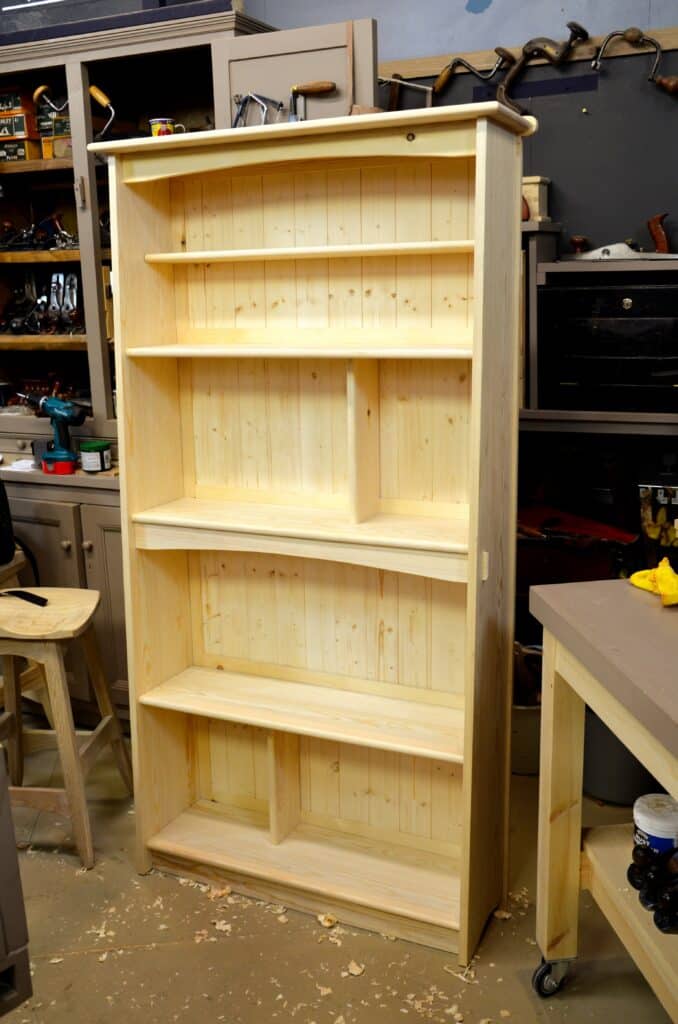
Ever since I began teaching other woodworkers the art and craft of hand-tool woodworking I have found myself more dismantling the erroneous perceptions that it’s hard, complicated and even impossible without special training through an apprenticeship, things like that, but then too that it is slow, outdated, that you need years and years of practice or some special Moravian-style workbench with a range of vise components, holdfasts and much more besides. When I put myself in the shoes of someone who wanted to start out in woodworking were to face needing to spend a thousand pounds on three bench planes, over two hundred euros on a panel saw, another thousand dollars on three backsaws to cover the various needs of bench joinery and such, well, I probably wouldn’t and couldn’t have done it. Of course, it doesn’t end there. What about a plough plane and router plane, both needed but five hundred pounds to own them???
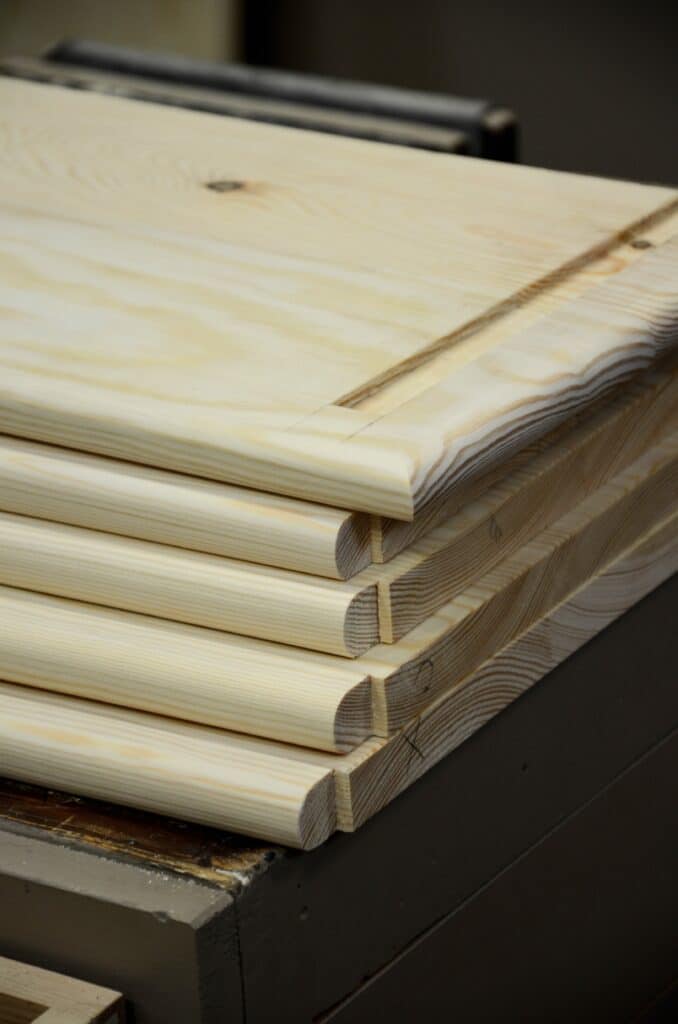
I did eventually acquire such high-priced versions but not for the reasons some might do so. I wanted to know truthfully if any of them achieved more than say an older secondhand version by Stanley or Record, the ones I grew up with and saw used throughout the woodworking industry of my youth. I wanted more just to try out the feel of them and to give them an educated trial from a crafting artisan’s point of view instead of a mere opinion. I wanted to see whether they really offered any more than convenience, yes, but I also wanted to get people seriously understanding that it’s the sharpens and set that they must master early on if woodworking was really going to work for them. I also found it necessary for woodworkers to understand that most magazine editors were just that and most often not particularly good woodworkers if they were woodworkers at all. All of the UK woodworking magazine editors were not woodworkers in any way. That was a good enough reason for me to stop writing for them. thankfully, one by one they are going down. facing the reality of them, most of them if not all are associated with advertising and are advertising platforms and little more.
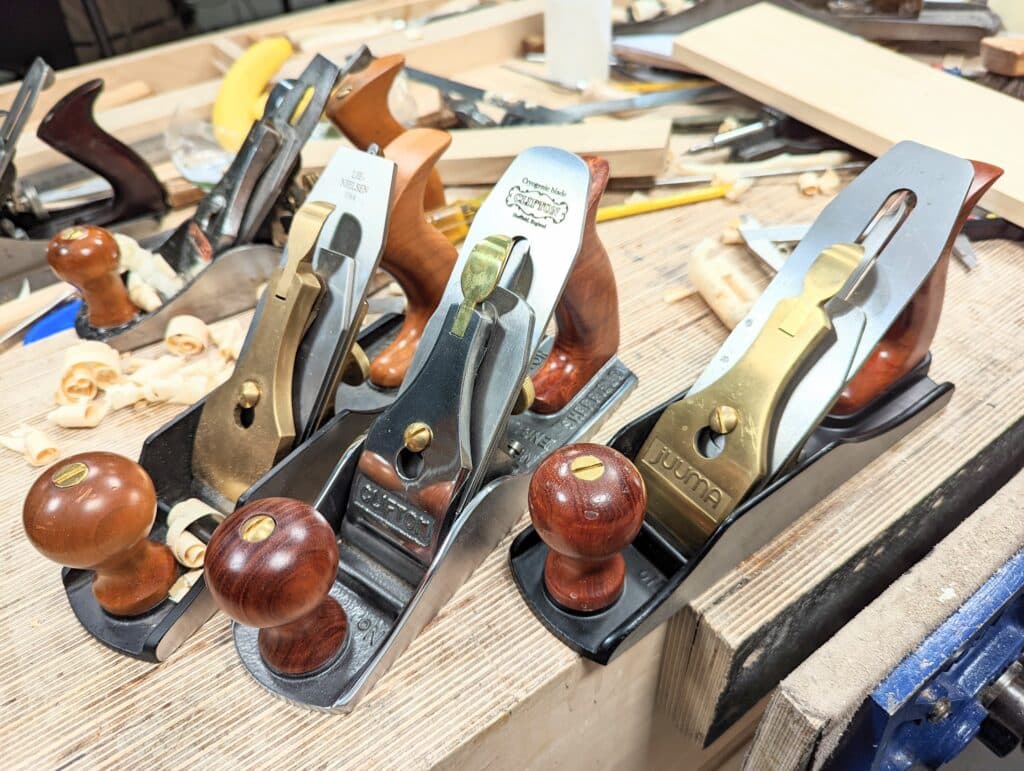
So, what happened to these premium tools? They are still back in their boxes. This year I plan to get rid of the excesses. I have accumulated hundreds of tools to do my research over the years. It’s time to distil down.
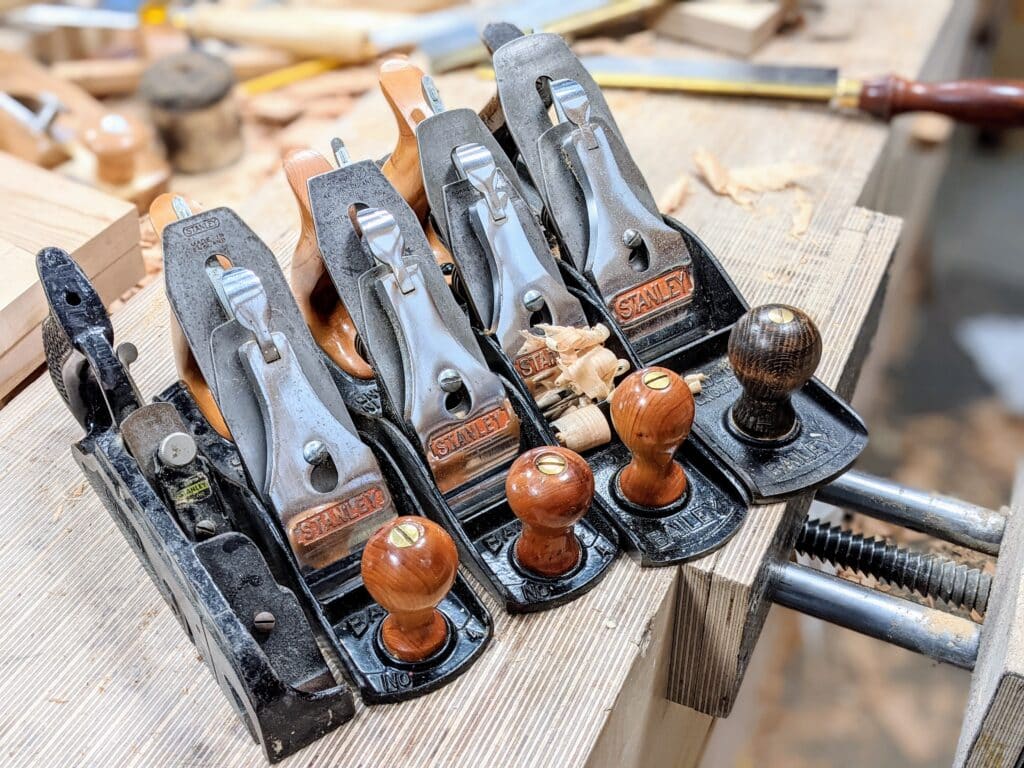
One of our most successful video series has been the simplified English Joiner’s Workbench. this workbench with my inexpensive source for bench tools got woodworkers around the world in the saddle straight off. Once I convinced new woodworkers to give it a go and sharpen that saw, make that bench and buy that old #4 Stanley we were off. The first project we filmed was building my workbench in the back garden of my rented house in North Wales where the seagulls screeched overhead and the children screamed in Welsh in the playground next door. It was magic. But in that early presentation of online Paul Sellers, I did wonder with the few hundred views how this was going to work. Fourteen years on, still no regrets. The days are full on teaching, training, making and sending it out to hundreds of thousands.
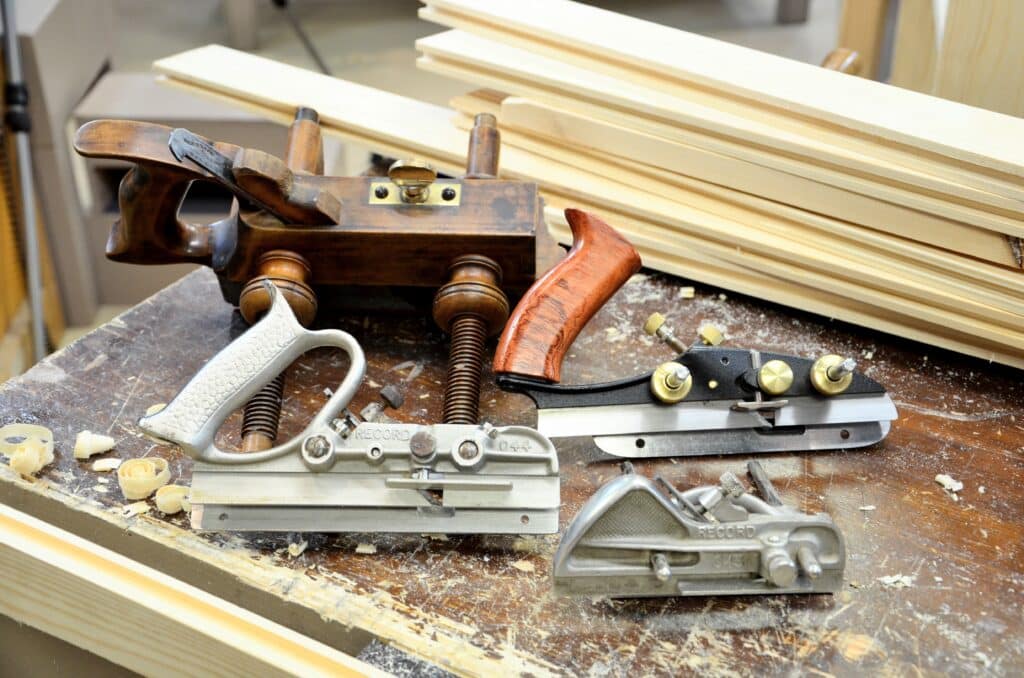
When we made the shelf unit we were able to create so much content packed into a few episodes people were stunned by it. We trialled four different planes covering 150 years of planemakers and found all of them coequal in ability and quality. The wooden Sandusky was the single most pleasant but of course, we couldn’t recommend it because it wasn’t available universally. What we did show then was that you could acquire a Record or Stanley version with three to a dozen cutters sometimes for only ten pounds but anyway, usually, under fifty.
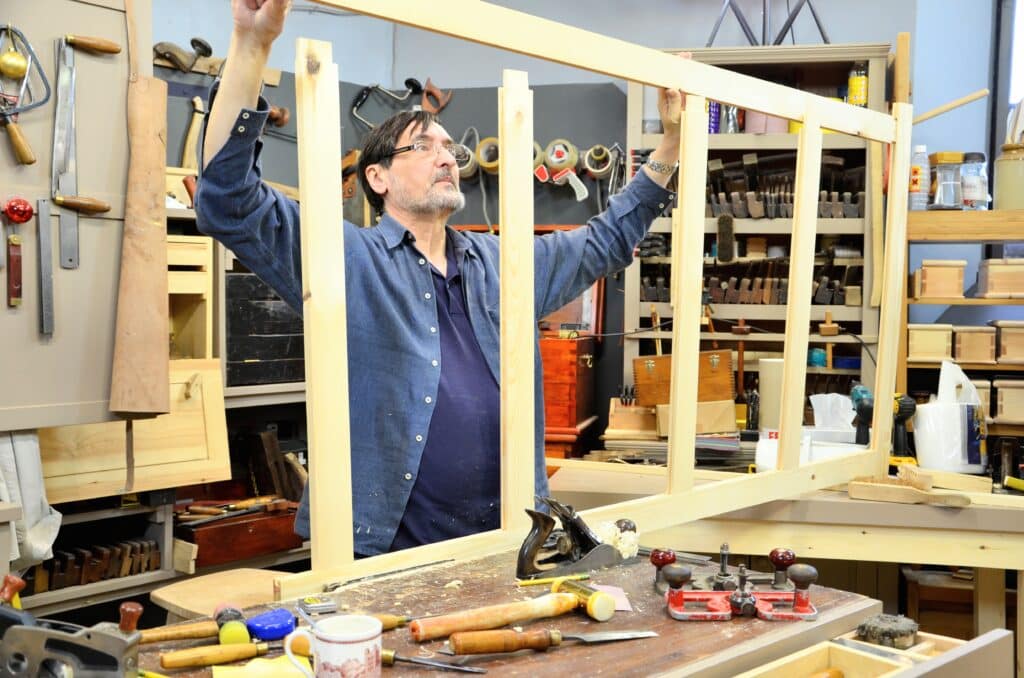
There are many elements in this project I included that will be missed in the overall and final appearance. How are the shelves adjusted and what holds them so well? Well, it’s nothing more than a wire coat hanger with bends that form a spring in two holes. When someone shows you this thing with a slight spring you ask yourself now why didn’t I think of that? And here is another thing. Over the decades I have shown a hundred thousand people how to make bull-nosed edges to shelves, stair treads and window sills using nothing more than a common #4 Stanley bench plane and any wood you care to name. You do not need a moulding plane or a power router. They will only mess you up and so too your workspace.
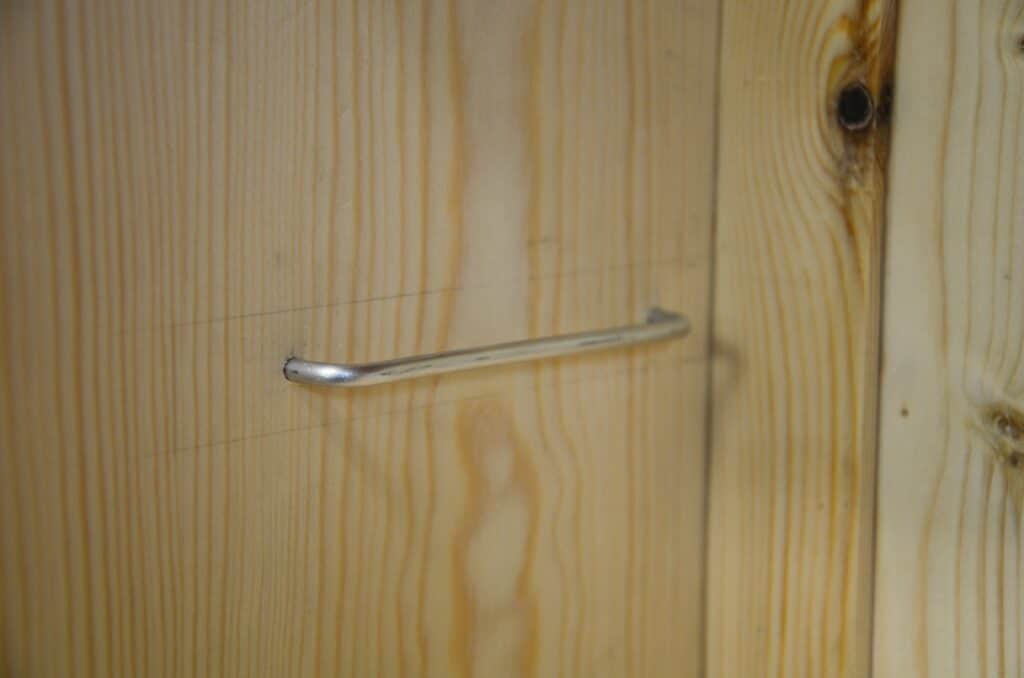
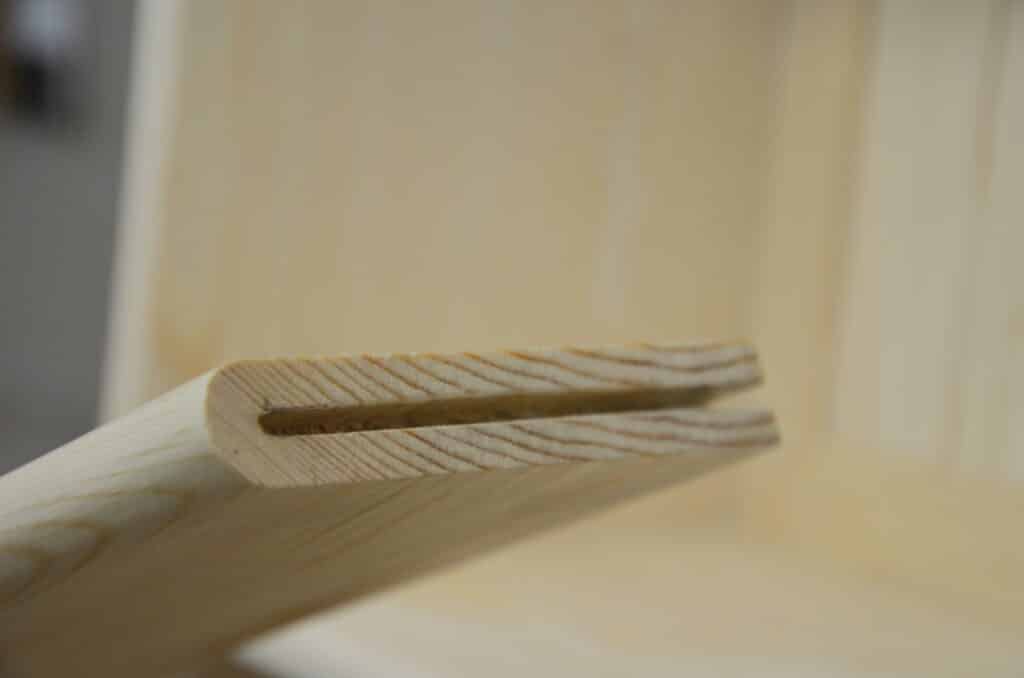
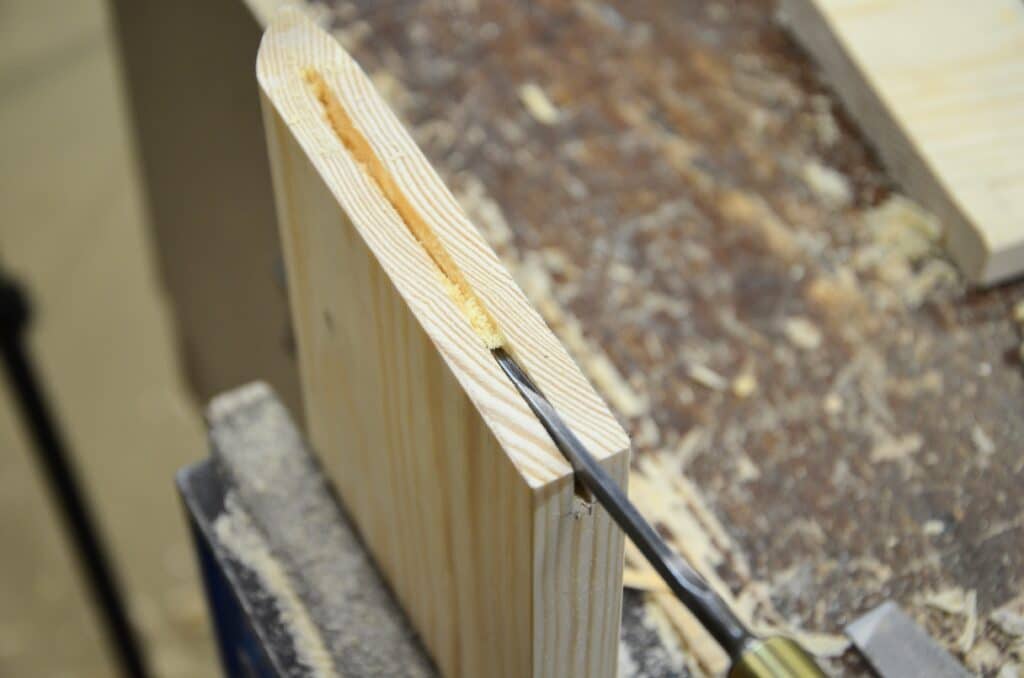
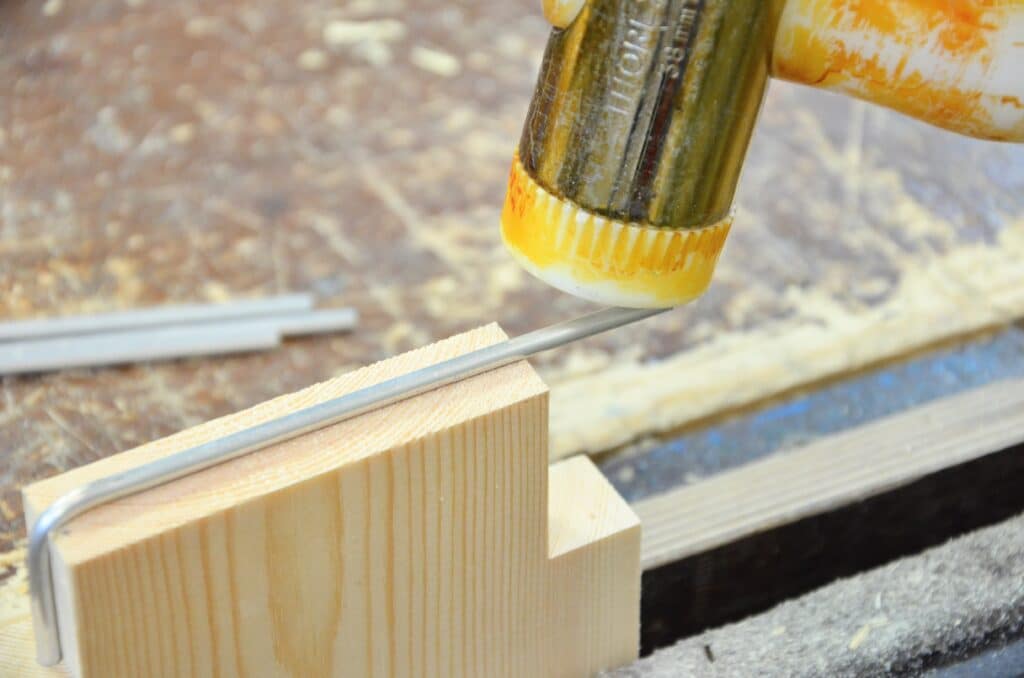
And just how do you cope a matching cove to correspond perfectly to a bull-nosed edge or an internal corner anyway? When someone shows you why to put the blade in so that it cuts on the thrust or push stroke and not the pull stroke it just makes good sense.
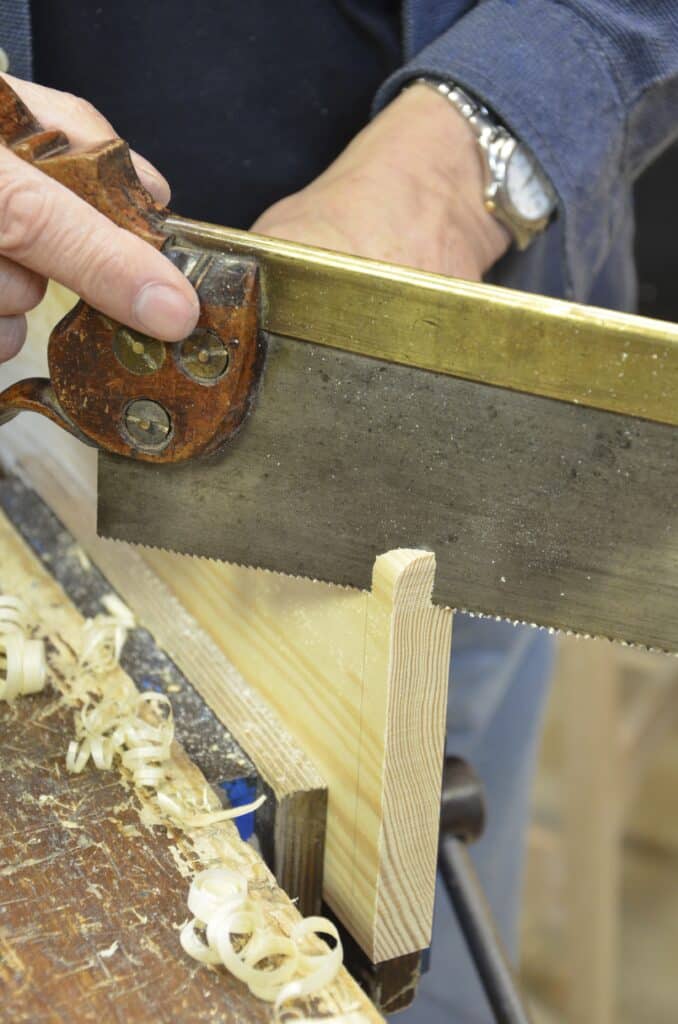
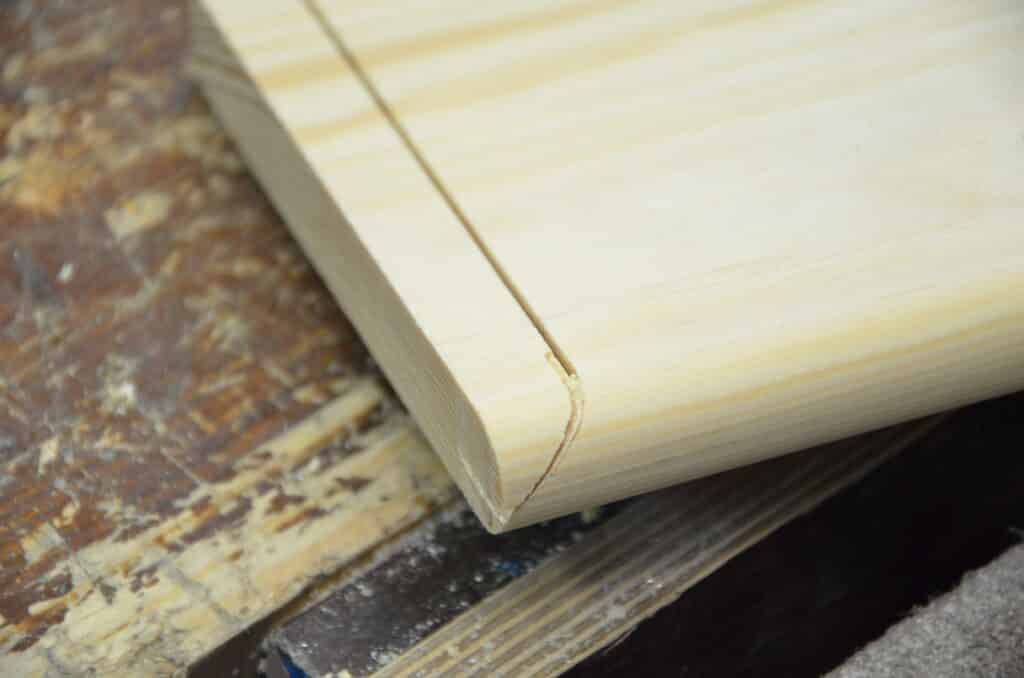
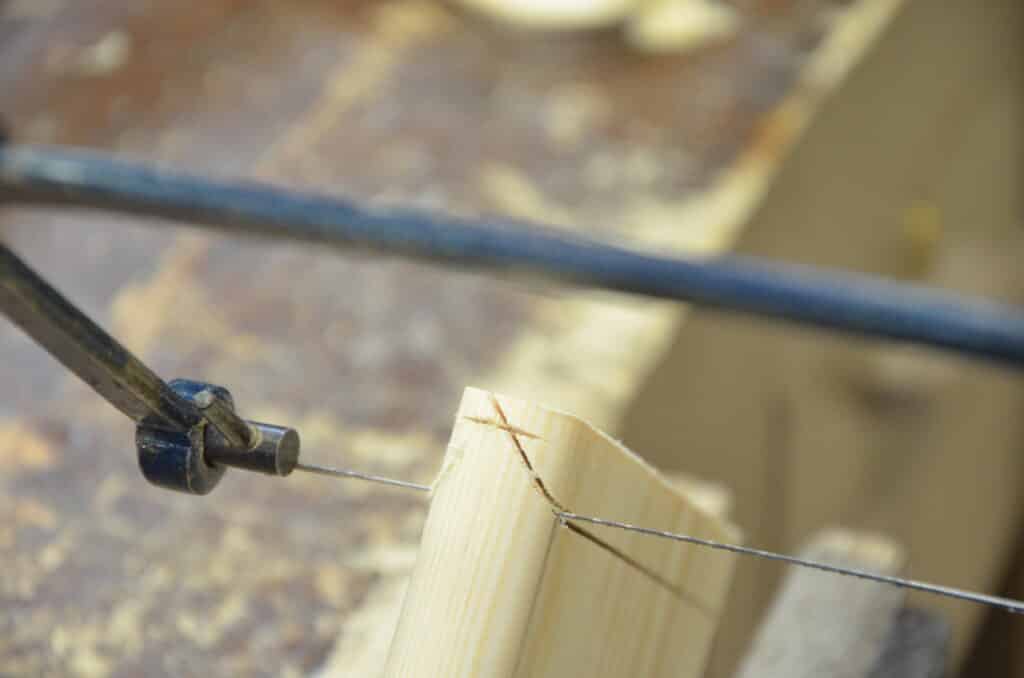

The cut is more powerful and you can see your line much more clearly. Did you know that this is the correct way to load the blade anyway, except when we are desperate because of things like COVID? In the last decade of producing online content every week, we have never missed a single five-o-clock Wednesday deadline. that’s because we all have the same dedication to educate. we are not an advertising medium, we do not take payment for product placement, no manufacturer can afford us anyway and not one of them can match our reason for producing what we do.
So, with hundreds of episodes under our belt, you can access first-class help from the experts in every sphere of our work. you can access half of them for free simply by subscribing here. If you want to go deeper you should pay a modest fee for a membership where you can access every episode we have ever made. it’s your choice.


I picked up a Stanley 13-030 a bit after the article back in the day. Paul’s complaint about the plastic handle being not the nicest in hand but a good shape, led me to make a new one out of wood. I found a piece of Osage Orange and made a handle using the techniques from Paul’s plane handle video but copying the shape of the original. Excellent tool.
My only plane that I bought new, in my youth, is a Stanley “with” plastic handles. The rear handle didn’t last long and I replaced it with a Record one bought from a local tool shop, sadly now gone.
When Paul did the videos on making new handles, I did consider making a front one, but didn’t. Over 50 years of use it had worn smooth, and felt on different to a wooden one. The finish in the rear handle had crazed, I simply applied shellac to them both. I wonder if anyone would now realise that it is plastic. Although I must admit that my favourite no4 is a Record that I purchased more recently. Over the years I seem to have aquired 4 no 4s, all get used regularly.
I remember that was the plow plane article Paul wrote some time ago. In the U.S I found a Stanley 12-250 that he also recommended. The handle doesn’t bother me but but it seems more of a combination plane and the extra skate is another nuisance. It came with a 17 blade card set but all I ever use is the plow blades. Sometimes I wish it was a 13-030 just for weight and simplicity reasons.. But it works well and got it for a reasonable price for a English plane that is rather the U.S.
Paul, I could not agree with you more when you say repurpose old tools, it is much cheaper. I am an 83 year old Australian resident in Sweden and when it came to purchasing woodworking tools, I used the local version of E-bay. All my chisels are from E A Berg and would have to be at least 60 years old and simiarly most of my planes are wood with E A Berg blades. I do have some power tools, but these are not used regularly. Keep up the good work.
Hi Paul,
I remember watching the early videos making the bench in the back yard, the castle workshop and all through the house build videos. All very informative and enjoyable.
Thank you, keep up the good work.
Sincerely,
Myron Swenson
Paul
If you are going to sell or give away your excess tools many of us would like to buy them or assist you in down sizing your tool excesses.
Peter Gowdey
I have no disagreement other than to say that I appreciate Lee Valley for making tools for us southpaws. I had one guy tell me once that if I were a real woodworker I’d be able to use tools as deftly with my off hand as with my “on” hand. Well, I’m not a real woodworker, I guess. And as a hobbyist, I appreciate being able to get my hands on Lee Valley’s left-handed plow plane for drawer grooves, etc. So that’s a new tool that to me is well worth the premium price, considering that to my knowledge neither Stanley nor Record produced a similar tools for lefties.
Right handers always say things like that. However, if they were forced to use all lefthanded items, they would sing an entirely different tune. My daughter recently broke her right arm, and shortly thereafter was forced to use right handed scissors with her left hand. According to her it was not a good experience. She now understands my dilemma
Swapping the old stanley and records from left to right is really just a matter of swapping the fence from teh right to the left side of the plane. I have and old record 50 and an old stanley 45 that I setup one for left handed and one for right handed so I can running against grain when doing lots of frame grooves whne not doing dead center grooves.
Amazing. So good to read this as I’m doing the same in a different way.
I retired 10 years ago, and set out to fulfill my dreams in woodworking, having had an academic medical career. I bought lots of “kit” and used very little of it. I quickly realised the sense of enjoyment restoring an old tool which worked well but needed a clean up. The new super models I bought initially are gradually being sold off. And lots of folk think I must have been doing this for years with my polished and pitted planes and saws!!
I’ve learned a lot from Paul, and others, about the value of using my hands and skills new to me.
I recently rewatched the very video. I know the most recent one is probably a wee bit more rigid, has better wear characteristics, and will suffer fools more readily……but the one in the back yard still has the most class! Today I straightened all but one edge of my new bench top, and the paws ache. This will pass and I earned every inch of straight!
Love your content. Just noticed a small typo near the end: madfe —> made.
frankly I find your poor man’s planes adequate for my needs. I’ve even prettied them up a bit and made the chisel/irons dedicated parts.
The original workbench series in your back garden were the first videos of you that I watched. I’m not quite sure how I happened to find them, but I do think I was searching for resources on building a workbench. I was totally expecting to have to buy some more powertools, actually completely unaware that handtool woodworking even existed. Seeing you build the bench immediately had me captivated. I still recall the feeling of realising that using handtools is the road to making any project you need or can think of. Discovering your channel, and a bit later on woodworking masterclasses, was nothing short of life changing. Thank you, Paul.
I totally loved that original workbench series.
Your instruction and detailed explanations encouraged me to acquire a few tools, pick up these hand tools (already found two older planes and another online buy arriving today-a Stanley 5 1/2) and working with them. I understand my cuts won’t be perfect the first few tries, but the joy I get when a joint fits (I cut my first thru mortise in hard maple recently) is boundless. I turned 67 yesterday and feel like a kid at school’s end when I get to work in my shop.
Thank you so very much.
PS: My birthday present was your book and DVD set on hand tools and the 100 year old Stanley.
That first backyard workbench video is still my favorite. I can never forget stumbling on it at night in bed and I couldn’t stop watching the episodes. I stayed up many hours past my bedtime transfixed at what I was watching and finally hearing a man share his unvarnished opinions (backed up with real life experience). How refreshing was that!? In that series alone I learned about knife walls, how to property use a square, how to chop a mortise, etc. I’ve been a fan ever since. If anyone here hasn’t see the backyard workbench episode, you’re depriving yourself of a “must see.”
Thanks for taking the trouble to write here, Larry. I did enjoy the adventure starting there and I am so glad we took that step. It would not have been my preference at the time particularly but growing with it has now enabled hundreds of thousands of woodworkers to get off the conveyor belt and master the real woodworking skills they once only dreamed about. You know, I have never once said don’t use machines or that I dislike them and yet I have a reputation for somehow “hating” them. Not true in any way.
It would be a good trip down memory lane if you do a project in the garden of the Sellers home, in the spirit of those early videos.
I too got my eureka moment when I saw those, and they made a lasting impact.
The sound of seagulls and school children could be added artificially if need be, but I am sure the real ambiance will be perfect. 🙂
I also used the garden, bench videos to create my variant of the double sided bench. It has an end as well as a side vice. Its stability and flexibility made a great difference to me.
It has been interesting to share Paul, the website, the audience and myself changing over that period of time. It has changed the way that I look at things. Unfortunately I seem to struggle passing up on a tool that I see in need of restoration. I know that really I have too many, but it means that I can swop planes as they are all set differently and have chisels sharpened at different angles.
My latest 50p purchase included an old chisel that needed a new handle, which I had, and a regrind, which I try to avoid doing. It is now a great chisel.
Paul, I can’t thank you enough for what you have done for myself and many others.
Keith
Inspired by Paul’s video on restoring old planes I bought a Stanley 4 and 5 1/2 on EBay. It was such fun and so satisfying to get them into shape, the best sort of recycling. They work brilliantly and look beautiful (which my family thinks is very sad but I have a smug grin!). Thanks Paul
I suppose I was early enough for veritas to still be quite reasonably priced. I got the router for maybe 70 back then and the 71s were on eBay for 50 plus. I do wish I’d bought the plough back then. The key 10 years ago was to try to buy it before Paul recommended it 😂 as this would lead to an overnight increase of 25%. These days looking at current makers the prices are unattainable. So much so that I would’ve really struggled to get started. Paul really did open the door to an idea of not needing much to create lovely functional things. And I still use the same design of bench that Paul showed us from his back garden all those year ago. Thanks Paul and team your legacy will live on through us and generations to come
I would also say that a lot of current hand woodworking content creators shall we say, look no where near as comfortable as Paul does. You can see when they do things, that ourselves as Paul sellers students can do comfortably through years of grooving techniques and building mussel memory. Their version seem cumbersome not in any way practiced. Many are writers, content creators etc but they certainly don’t have the level of feel and understanding you see Paul use with every stroke. From first finding you on YouTube then woodworking Masterclasses’s it really has been a very enjoyable apprenticeship thanks Paul
The difference? I never watch another to create content to make money. It all comes from a lived life.
Long may it continue
I tell anyone who will listen, I’ve learned more from Mr. Sellers in the last ten years than I did in the 40 before. Including advanced degrees. Thank you sir!
Paul has an advanced degree; he just doesn’t have a certificate from some institution. He has put as much or more study and dedication into his profession as anyone has for a PhD.
I came to hand tool woodworking after lopping off half my left index finger with the table saw, during covid. I have come to view it (the lop) in a positive light due to the immense enjoyment I get from using hand tools. Used tools are difficult to find here in Mexico, but the Veritas router plane is my only new one. Thanks for your efforts Paul.
I never would have found my way to hand tools without that incident.
I love my subscription to you on email. I was wondering if you have ever used these Japanese pull saws? Plus I guess it goes without saying. But doesn’t a lot about the quality of woodworking depend on keeping tools very sharp? And is it very difficult to make and use homemade tools like hand planes, router planes, etc?
PS. I love the fact that your an artist as well as a woodworker.
No, I never use pull-stroke saws as I have no need to use them. They are of course, 98% non-resharpenable and therefore most often designed as a disposable or throwaway saw. that also means that the skills I strive to encourage like sharpening, setting and adjusting you personal saws cannot be achieved. So these are all excellent reasons not to use them. It takes me four minutes to resharpen a western push stroke saw to suit the different sawing tasks. I have been sharpening the same half a dozen of my personal saws about once every few weeks for around sixty years so far. This is good value for money as each of them would have cost me £3 when I started my apprenticeship in 1965. Looking at the steel that’s left, I will be able to sharpen them for another 120 years.
Another brilliant post Paul
I have learned so much from your videos since retiring in 2017. Having had a ‘desk’ job for life, exploring my love of wood and manual work as a hobby fitted well. I’ve made your plywood workbench design and used it to make ukuleles using recycled timber, children’s stools and a toy box, a rocking horse and several chess boards among other items.
Thanks to you, I discovered hand tool renovation, the pinnacle of which was a friend trusting me to renovate his late cabinet-maker father’s planes which were the worse for wear. Having brought 7 planes back to working life, my friend insisted I keep three of them for my trouble. The others he is using on a barn renovation project.
Thank you Paul.
I’m interested in the technique for coping the bullnose edges that Paul mentions in this blog post. I’ve been searching the WWMC website for the video where that’s covered, but I can’t find it. The bookcase video I found from 2014 has components with square edges. Does anyone know where Paul covers this? Thanks.
https://paulsellers.com/2014/02/coping-coping-saws/
Thank you! I found that page just after posting my query, naturally.
Paul, I do enjoy watching your videos. Although I am well fitted in power tools, as I get older I find myself more and more drawn to hand tool work. I have finally learned to properly sharpen a plane and to use a shooting board. I’ve taken a liking to box building, and tonight I did something that was a first in my 65 years on this orb – I successfully used a plough plane to cut the slots for the bottom of one of my boxes. The plane is a Record 044c I recently acquired in mint condition, complete with the original manual and a full set of very sharp irons in both metric and imperial sizes. Judging by the condition of the plane and irons, I suspect it has seen very little use since it left the factory. After a few test runs on scrap to get the feel of the tool and tweak my depth of cut, it was a lot easier to use than I expected . . and greatly satisfying, as well.
Tony Turley
There you go, Tony. And just when I cut four pristine grooves in dense-grained hardwoods using a 24″ripcut handsaw and the reason I did was because plough planes wont cut deeper than half an inch and I needed 1″ deep grooves. Yep! Another trick for my next video series. Oh, and it was faster than any plough plane. All skills, tricks of the trade and methods will be revealed before I depart this earthly sod. Have a good day.